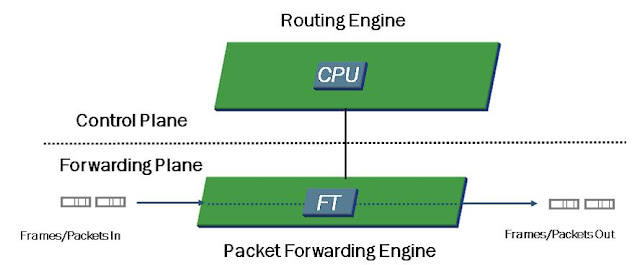Maintains Routing Engine Intelligence
The RE handles all protocol processes in addition to other software processes that control the device’s interfaces, the chassis components, system management, and user access to the device. These software processes run on top of the Junos kernel, which interacts with the PFE. The software directs all protocol traffic from the network to the RE for the required processing.
Controls and Monitors Chassis
The RE provides the CLI in addition to the J-Web GUI. These user interfaces run on top of the Junos kernel and provide user access and control of the device. We discuss user interfaces in a subsequent chapter in this course.
Manages Packet Forwarding Engine
The RE controls the PFE by providing accurate, up-to-date Layer 2 and Layer 3 forwarding tables and by downloading microcode and managing software processes that reside in the PFE’s microcode. The RE receives hardware and environmental status messages from the PFE and acts upon them as appropriate.
Forwards Traffic
The PFE is the central processing component of the forwarding plane. The PFE systematically forwards traffic based on its local copy of the forwarding table. The PFE’s forwarding table is a synchronized copy of the information created on and provided by the RE. Storing and using a local copy of the forwarding table allows the PFE to forward traffic more efficiently and eliminates the need to consult the RE each time a packet needs to be processed. Using this local copy of the forwarding table also allows platforms running the Junos OS to continue forwarding traffic during control plane instabilities.
Implements Services
In addition to forwarding traffic, the PFE also implements a number of advanced services. Some examples of advanced services implemented through the PFE include policers that provide rate limiting, stateless firewall filters, and class of service (CoS).Other services are available through special interface cards that you can add to the PFE complex.
Transit Traffic
Transit traffic consists of all traffic that enters an ingress network port, is compared against the forwarding table entries, and is finally forwarded out an egress network port toward its destination. A forwarding table entry for a destination must exist for a device running the Junos OS to successfully forward transit traffic to that destination. Transit traffic passes through the forwarding plane only and is never sent to or processed by the control plane.
By processing transit traffic through the forwarding plane only, platforms running the Junos OS can achieve predictably high performance rates.Transit traffic can be both unicast and multicast traffic. Unicast transit traffic enters one ingress port and is transmitted out exactly one egress port toward its destination. Although multicast transit traffic also enters the transit device through a single ingress port, it can be replicated and sent out multiple egress ports depending on the number of multicast receivers and the network environment.




